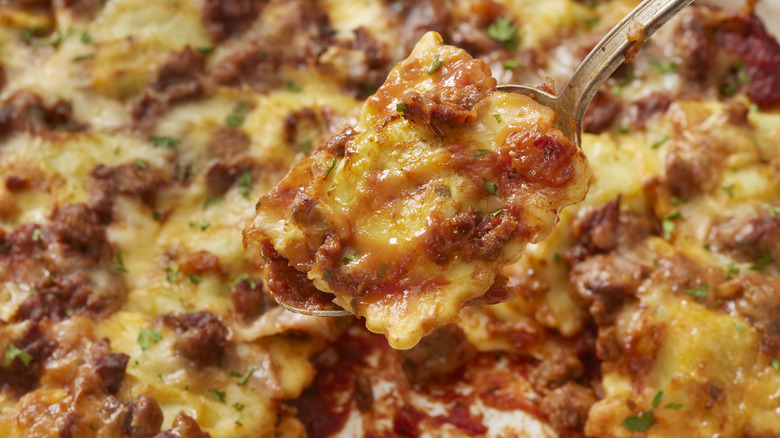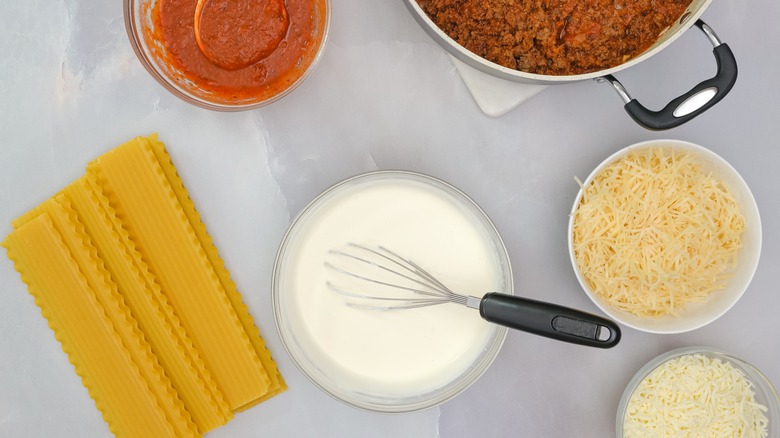Giada De Laurentiis' Sheet Pan Technique For Crispy Lasagna Edges
If your family fights over the crispy corners of lasagna every time you bake pasta, Giada De Laurentiis has a solution that just might put a stop to those noodle-inspired tiffs. For maximum crispiness, try using De Laurentiis' technique for layerless lasagna, which the erstwhile Food Network star explains in a YouTube video.
To kick things off, De Laurentiis opts for shorter noodle pieces, instead of full-length lasagna noodles. Rather than layering the noodles with sauce and cheese, she mixes everything together and then spreads the cheese and sauce-coated noodles on a sheet pan. Bits of the noodles stick out over the top of the mixture, creating a bumpy texture (and more pasta corners to crisp up).
De Laurentiis places all of this into the oven until it's golden brown and crispy. And while her cooking process might seem pretty par for the course as far as baking lasagna goes, a unique combination of factors — the cut of the noodles, the cheese, the shallow pan without a cover — produces the crispy lasagna noodles that she and so many other pasta-loving foodies adore.
Deal with the noodles De Laurentiis' way
Lots of home cooks boil their pasta noodles before putting them into their lasagna. Some even cook the pasta until the noodles are completely soft. This is a mistake, since they will continue to cook in the oven after they're removed from the stovetop, making them soggy (and, of course, soggy noodles equals less crispiness to enjoy). While most lasagna noodles cook on the stove in the space of eight to 10 minutes, Giada De Laurentiis boils her pasta on the stovetop for half that time – four minutes, max. This prevents the noodles from becoming mushy.
As far as working with the shortened noodles that De Laurentiis' dish requires, home chefs have a couple of options. They can break up the long pasta noodles by hand. The resulting pasta will look a bit uneven (you can call it rustic), depending on how the dry, uncooked noodles break up, but they'll still serve their purpose. Or home pasta makers can use mafalda or taccole pastas, which look like miniature rectangles of lasagna noodles — frilly edges and all. The latter are the noodles that De Laurentiis uses for her recipe.
The cheese, the heat, and everything else
Aside from making her easy lasagna ooey, gooey, and cheesy, Giada's practice of stirring the pasta noodles into the mix of cheese and sauce has another advantage. It coats each noodle with plenty of sauce and cheese, allowing her to work in just one layer. A thin layer of ingredients is more likely to end up crispy than layers of stacked lasagna noodles, cheese, and sauce because less moisture can pool at the bottom of the pan.
Once the sheet pan of pasta goes in the oven to bake, the heat takes the cheese and the noodles from lightly colored to golden and crispy in the space of half an hour thanks to the Maillard reaction. This occurs when the temperature reaches between 280 and 330 degrees Fahrenheit. From there, a chemical reaction takes place between the amino acids and sugars in the food, turning the food brown and crispy. Because De Laurentiis cooks her lasagna at over 400 degrees Fahrenheit, there's plenty of heat to create the Maillard reaction.
The celeb chef also maximizes crispiness by not covering the lasagna with foil. Doing so would keep the pasta moist, effectively stopping the Maillard reaction. All of this taken together adds up to more crispy cheesy-covered pasta pieces to fight over.


